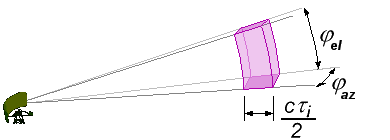Pulse volume
The pulse volume is a characteristic feature of radar and describes the common resolving power of the radar device according to the distance and the angular coordinates. Basically, if there are several targets within the pulse volume, there is no target separation. Only one target mark is shown by the radar.
It is usually assumed that the pulse volume is limited by the half- width φ of the antenna directional diagram. Two important pieces of data from the antenna diagram are used here to define an area: the vertical half-width and the horizontal half-width of the antenna. These two values are part of the radar's angular resolution. The distance, which is calculated from the transmitted pulse duration of the radar device and the speed of light , is used as the third coordinate for a volume . This value is called the range resolution of the radar.
Distance resolution
The minimum target distance (distance resolution ) results from the parameters of the transmission pulse duration , the speed of light , and the factor ½ (there and back of the transmission signal):
A transmission pulse that is as short as possible is needed for a good distance resolution. Alternatively, there is the possibility of using the pulse compression method to achieve a better resolution.
Angular resolution
The angular resolution of a classic pulse radar device is determined by the antenna parameters. The angular resolution is determined here in a similar way as in optics with the Rayleigh criterion . The angular distance between two targets should be greater than the zero angle, i.e. the angle between the maximum and the first zero point. This zero angle is difficult to measure with radar devices because it is usually either overlaid with noise or covered by threshold value circuits. For this reason, the half- width of the main lobe of the antenna is often used in radar devices to determine the angular resolution, which is similarly large to the zero angle with sufficient accuracy.
In general: if two targets are at the same distance within the opening angle Θ of the main lobe of the antenna diagram, they are displayed as one target.
Azimuth resolution
For targets at the same distance from the antenna, the azimuth resolution specifies the minimum distance the targets must have tangentially to one another so that they can be differentiated in terms of the azimuth. In contrast to the distance resolution, the azimuth resolution is also dependent on the distance. The mathematical relationship can be shown using the right-angled triangle from the graphic as follows:
- = Azimuth resolution
- R = oblique distance target - antenna
- Θ = opening angle of the main lobe (Greek letter: theta)
Elevation angle resolution
For targets at the same distance to the antenna, the elevation angle resolution indicates the difference in flight level (distance in height) between the targets so that they can be distinguished in elevation angle. This parameter is only important for 3D radar devices , since 2D radar devices have a fan diagram or a Cosecans² diagram anyway and can only recognize different targets, which differ from each other only in the elevation angle with otherwise the same coordinates, as a single target.
The azimuth resolution formula can be used to calculate the elevation angle resolution if the half- width at half height of the antenna is used as the value for the opening angle.
In the case of phased array antennas that electronically pivot the diagram in the elevation angle, it is quite possible that one of the two targets is also detected by a radar beam from a second direction. Here, as an exception , the radar data processor can separate the two targets due to the rapid movement of the radar beam, even though they are actually flying too close to each other and therefore both are within the pulse volume.
Individual evidence
- ↑ Wolfgang Keydel, Antennas and resolving power in microwave remote sensing, DLR Institute for High Frequency Technology and Radar Systems, p. 3 PDF online









